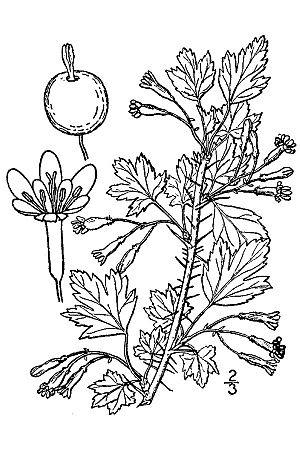Canadian gooseberry facts for kids
Quick facts for kids Canadian gooseberry |
|
|---|---|
 |
|
| ssp. setosum | |
| Conservation status | |
| Scientific classification | |
| Genus: |
Ribes
|
| Species: |
oxyacanthoides
|
| Synonyms | |
|
|
The Canadian gooseberry (scientific name: Ribes oxyacanthoides) is a type of flowering plant. It belongs to the gooseberry family. This plant grows naturally across North America. You can find it from Alaska all the way through Canada and into parts of the western and central United States.
Contents
What are its different types?
The Canadian gooseberry has several different types, called subspecies. Think of them like different versions of the same plant. Each subspecies has its own common name too. Scientists used to think these were completely separate plants. But now they know they are all part of the same Ribes oxyacanthoides species.
Here are some of the main subspecies:
- R. o. ssp. cognatum is also known as the Umatilla gooseberry or stream currant. It grows in the Pacific Northwest region.
- R. o. ssp. hendersonii is called Henderson's gooseberry. You can find it in Idaho, Montana, and Nevada.
- R. o. ssp. irriguum is known as the Idaho gooseberry or inland black gooseberry. It also grows in the Pacific Northwest.
- R. o. ssp. oxyacanthoides is the northern gooseberry. It grows from Alaska all the way to Newfoundland.
- R. o. ssp. setosum is often called the inland gooseberry or Missouri gooseberry. It lives in the Rocky Mountains and nearby areas.
What does it look like?
This plant is a shrub that loses its leaves in the fall. It usually grows to be about 0.5 to 1.5 meters (20 to 60 inches) tall. That's about as tall as a person! One type, ssp. hendersonii, can be a bit smaller when it's fully grown.
The branches of the Canadian gooseberry have small, sharp points called prickles. It also has longer, sharper spines up to 1.3 centimeters long. These spines are found where the leaves grow from the stem.
The flowers are usually white or pinkish. They can grow alone or in groups of two or three. After the flowers, the plant produces a berry. These berries can be up to 1.6 centimeters wide. They come in different colors like reddish, greenish, purple, or black.
Where does it grow?
The Canadian gooseberry can grow in many different places. It often grows near water, like on riverbanks. You can find it in forests, especially boreal forests, which have lots of conifer trees. These are usually at lower elevations.
Some types of this plant, like the smaller ssp. hendersonii, can grow in higher places. You might find them in mountain areas with loose rocks, called talus.
How does it affect other plants?
This plant can be a host for a plant disease called white pine blister rust. This rust is a type of fungus that can harm pine trees. Because of this, sometimes Canadian gooseberry plants are removed to help protect pine forests.
How is it used?
The Canadian gooseberry and its fruit are a small part of the diet for some wild animals. For example, grizzly bears and mule deer might eat them.
People can also eat the berries. Many Native American groups collected these berries and stored them for food. The Ojibwa people, for instance, would cook the berries with sweet corn. They also made the berries into preserves. Beyond food, the roots of the plant were sometimes used as medicine.


